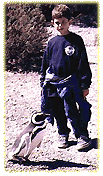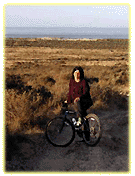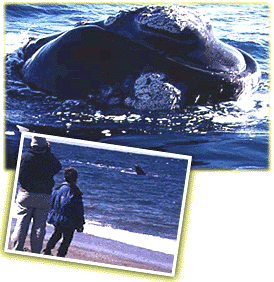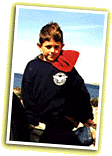 |
 |
 |
|
|||
|
Touring Patagonia
Just south of the Peninsula, half a million Magellanic penguins come ashore at Punta Tombo each spring to reproduce. They're named after Magellan, the first white explorer to land in Patagonia in 1520. The animals still outnumber the humans 10 to one. Small groups of Argentinean tourists step gingerly around the nesting birds who eye them with indifference.
I wanted my son Adam to see that places like this still exist. Dozens of foot high birds in black tuxedos waddle up the beach calling for their mates. The birds are so thick, it's like New York city during rush hour, with every one dressed for the theater. It was this kind of scene that sent Charles Darwin into ecstasy when the Beagle sailed here in 1832 and got him thinking about natural selection.
Flavio's pickup truck is riddled with holes. Every time a car passes, he has to brace the windshield with his hand so glass doesn't wind up in our laps. Rental cars are 200 dollars a day and ill-suited to the terrain. We pass a mangled steel carcass left as a warning to bad drivers. If you're faint at heart, try the air-conditioned, double decker tour buses with tinted windows instead. Most visitors stay in Puerto Madryn. You can rent a room with a kitchen for about 60 dollars a night. Ten miles down the coast is Punta Loma, a national preserve for sea lions and cormorants. Perched on a cliff forty feet above the beach, a wooden platform gives us a perfect view of hundreds of sea lions mating, fighting, or nursing their pups. Black and red Cormorants nest right on the cliff face beneath us.
Our captain Diego steers the boat full speed into the Gulf and soon we are staring at the upended tail of one of the third largest creatures on earth. It looks like a black porcelain statue towering over the boat.
At first all we can see are some blurry white markings, then, like a picture slowly coming into focus, the whale's head surfaces. Whale watching in Golfo Nuevo is an exercise in mutual admiration. As the whale and her calf inspect us from below, we lean over the side to stare into a huge intelligent eye. Whales have had advanced brains for 30 million years. We humans, on earth for only one thousandth that time, nearly wiped them out. They seem to have forgiven us, and it's a good thing, too. One swipe of that tail, and we would be history. Although the population of tourists here has doubled in the past three years, Patagonia still remains as travel writer Paul Theroux described it. "The emptiest part of America." There is still wilderness here, and a sanctuary for wildlife unsurpassed in the more populous world to the north. More Information: Considering a trip to Peninsula Valdes?
e-mail: municipio_madryn@cpsarg.com snail mail:
Municipalidad de Puerto Madryn or contact:
Naturatur Bilingual Whale Guides
Jorge Reinoso tel (0965) 21785- Trelew
Conservation Group/NGO wildlife conservation
9120 Puerto Madryn- Chubut, Argentina
|
 | American Public Media Home | Search | How to Listen ©2004 American Public Media | Terms of Use | Privacy Policy |


 It's survival of the fittest on the gravel highways of Patagonia, sometimes
the only way across
hundreds of miles of desert. My Argentinean friend, Flavio Quintana, gives
us tips for staying alive.
It's survival of the fittest on the gravel highways of Patagonia, sometimes
the only way across
hundreds of miles of desert. My Argentinean friend, Flavio Quintana, gives
us tips for staying alive.
 After the sea lions, we head to Golfo Nuevo on the Peninsula's southern
flank. It's the hotspot for
whale watching.
After the sea lions, we head to Golfo Nuevo on the Peninsula's southern
flank. It's the hotspot for
whale watching.
 Info about accommodations, tours, etc., contact the City of Puerto Madryn
Tourism Department:
Info about accommodations, tours, etc., contact the City of Puerto Madryn
Tourism Department: